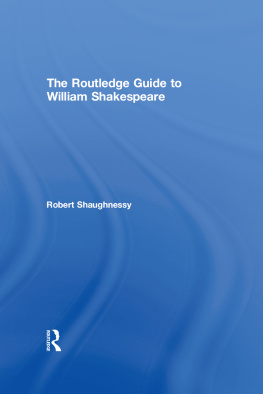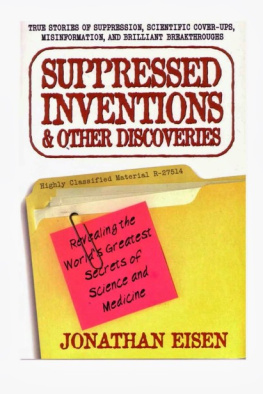ROUTLEDGE LIBRARY EDITIONS: SCIENCE AND TECHNOLOGY IN THE NINETEENTH CENTURY
Volume 7
DISCOVERIES AND INVENTIONS OF THE NINETEENTH CENTURY
DISCOVERIES AND INVENTIONS OF THE NINETEENTH CENTURY
ROBERT ROUTLEDGE
First published in 1901 by George Routledge and Sons Ltd
This edition first published in 2019
by Routledge
2 Park Square, Milton Park, Abingdon, Oxon OX14 4RN
and by Routledge
52 Vanderbilt Avenue, New York, NY 10017
Routledge is an imprint of the Taylor & Francis Group, an informa business
1901 Robert Routledge
All rights reserved. No part of this book may be reprinted or reproduced or utilised in any form or by any electronic, mechanical, or other means, now known or hereafter invented, including photocopying and recording, or in any information storage or retrieval system, without permission in writing from the publishers.
Trademark notice: Product or corporate names may be trademarks or registered trademarks, and are used only for identification and explanation without intent to infringe.
British Library Cataloguing in Publication Data
A catalogue record for this book is available from the British Library
ISBN: 978-1-138-39006-5 (Set)
ISBN: 978-0-429-02175-6 (Set) (ebk)
ISBN: 978-1-138-39275-5 (Volume 7) (hbk)
ISBN: 978-0-429-40205-0 (Volume 7) (ebk)
Publishers Note
The publisher has gone to great lengths to ensure the quality of this reprint but points out that some imperfections in the original copies may be apparent.
Disclaimer
The publisher has made every effort to trace copyright holders and would welcome correspondence from those they have been unable to trace.
THE GREAT WHEEL IN ACTION.
DISCOVERIES AND INVENTIONS
OF THE
NINETEENTH CENTURY
BY
ROBERT ROUTLEDGE, B.Sc.,
FOURTEENTH EDITION
CONTAINING FOUR HUNDRED AND FIFTY-SIX ILLUSTRATIONS
PREFACE

I N the following pages an attempt has been made to present a popular account of remarkable discoveries and inventions which distinguish the XlXth century. They distinguish it not merely in comparison with any previous century, but in comparison with all the centuries that have preceded, in regard to far-reaching intellectual acquisitions, and to material achievements, which together have profoundly affected our ways of thinking and our habits of life. In the latter, the enormously increased facilities of locomotion and international communication due to railways and steam navigation have wrought the greatest changes. These inventions depending primarily upon that of the steam engine, this first claims our notice, although properly assignable to a period preceding our era by a few years. Again, much of our material advancement is connected with improvements in the manufacture of iron and its applications in the form of steel, which have been especially the work of the last half of the century. So great has been the progress in this department, that for the present edition it has been found necessary to re-write altogether the article devoted to it. Our social conditions have also been greatly modified by the celerity of verbal intercourse afforded by the telegraph and the telephone, and these inventions have received appropriate notice in this work. In every branch of science also we have reason to be proud of the discoveries our era can claim, for they vastly excel in number and are not inferior in range to those of all the ages taken together. From so large a field, selection was of course necessary; and the instances selected have been those which appeared to some extent typical, or those which seemed to have the most direct bearing on the general advance of our time. The topics comprise chiefly those great applications of mechanical engineering and arts, and of physical and chemical science, in which every intelligent person feels concerned; while some articles are devoted to certain purely scientifi discoveries that have excited general interest.
The author has aimed at giving a concise but clear description of the several subjects; and that without assuming on the part of the reader any knowledge not usually possessed by young persons of either sex who have received an ordinary education. The design has been to treat the subjects as familiarly as might be consistent with a desire to impart real information; while the popular character of the book has not been considered a reason for regarding accuracy as unnecessary. On the contrary, pains have been taken to consult the best authorities; and it is only because the sources of information to which the author is under obligation are so many, that he cannot acknowledge them in detail.
The present edition has been revised throughout, and such changes have been made as were required to bring the matter into accordance with the progress that has taken place since this book was first published in 1876. But details given in the former editions have at the same time been retained where they served to indicate the successive stages of improvement. It would, for example, be impossible in a section on steam navigation, to omit some notice of the Great Eastern, and therefore the drawings and the account of the construction of that remarkable ship that appeared in the first edition, have been left with but slight alterations in the present volume, although the vessel has since been broken up. On the other hand, two sections are devoted to projects which the XIXth century has not seen realised; but the XXth century will in all probability shortly witness the completion of one or other of the great canal schemes; and if the first submarine tunnel is destined not to be one connecting England with the Continent, it will be one uniting Great Britain with her sister isle.
FOR permission to make use of illustrations in this volume the authors and publishers thanks are due to the several proprietors of The Graphic (for Plates I., XL, and XII.)of The Engineer (for sketch design of the Great Wheel, map and views of the Tower Bridge)of The Scientific American (map of North Sea Canal); also to Mr. Walter B. Basset (for Plate V.)to The Cassier Magazine Company (for Edisons Kinetographic Theatre and the Hotchkiss Gun)to The Century Company (for portrait of M. Tesla, from a photograph by Sarony) to The Incandescent Gas Light Company (for cuts of burners, etc.)to The Engineering Magazine, and The Engineering News, both of New Yorkto the Remington Companyto Mr. W. W. Greener, ef Birmingham (for cuts of rifles, etc., from his comprehensive book on The Gun)to The Photogram, Limitedto the Proprietors of Nature to the Linotype Companyand to Captains Hadcock and Lloyd (for illustrations of modern artillery from their great work on the subject).















